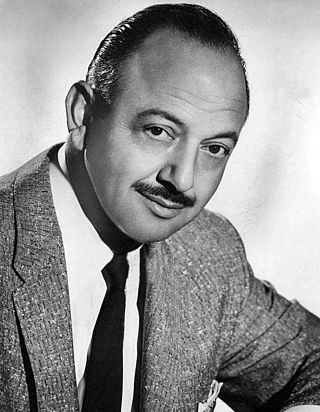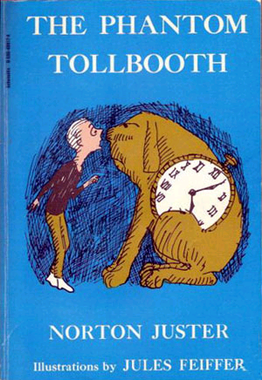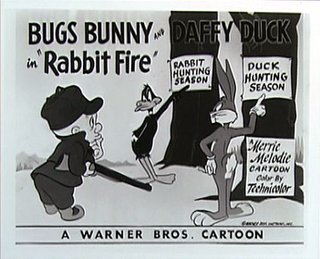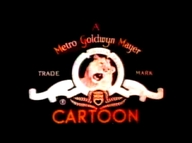
Melvin Jerome Blanc was an American voice actor and radio personality whose career spanned over 60 years. During the Golden Age of Radio, he provided character voices and vocal sound effects for comedy radio programs, including those of Jack Benny, Abbott and Costello, Burns and Allen, The Great Gildersleeve, Judy Canova, and his own short-lived sitcom.

Wile E. Coyote and the Road Runner are a duo of cartoon characters from the Looney Tunes and Merrie Melodies series of animated cartoons, first appearing in 1949 in the theatrical cartoon short Fast and Furry-ous. In each episode, the cunning, devious and constantly hungry coyote repeatedly attempts to catch and subsequently eat the Road Runner, but is always humorously unsuccessful in doing so. Instead of his animal instincts, the coyote uses absurdly complex contraptions to try to catch his prey. They comically backfire, with the coyote often getting injured in slapstick fashion. Many of the items for these contrivances are mail-ordered from a variety of companies implied to be part of the Acme Corporation.

The Phantom Tollbooth is a children's fantasy adventure novel written by Norton Juster, with illustrations by Jules Feiffer, first published in 1961. The story follows a bored young boy named Milo who unexpectedly receives a magic tollbooth that transports him to the once prosperous, but now troubled, Kingdom of Wisdom. Along with a dog named Tock and the Humbug, Milo goes on a quest to the Castle in the Air seeking the kingdom's two exiled princesses, named Rhyme and Reason. As Milo learns valuable lessons, he finds a love of learning in a story full of puns and wordplay, such as exploring the literal meanings of idioms.

Leon Schlesinger was an American film producer who founded Leon Schlesinger Productions, which later became the Warner Bros. Cartoons studio, during the Golden Age of American animation. He was a distant relative of the Warner Brothers. As head of his own studio, Schlesinger served as the producer of Warner's Looney Tunes and Merrie Melodies cartoons from 1930, when Schlesinger assumed production from his subcontractors, Harman and Ising, to 1944, when Warner acquired the studio.

Woody Woodpecker is an animated character that appeared in theatrical short films produced by the Walter Lantz Studio and Universal Animation Studio and distributed by Universal Pictures since 1940. Woody's last Woody Woodpecker was produced by Walter Lantz in 1972.

Norton Juster was an American academic, architect, and writer. He was best known as an author of children's books, notably for The Phantom Tollbooth and The Dot and the Line.

Jules Ralph Feiffer is an American cartoonist and author, who at one time was considered the most widely read satirist in the country. He won the Pulitzer Prize in 1986 for editorial cartooning, and in 2004 he was inducted into the Comic Book Hall of Fame. He wrote the animated short Munro, which won an Academy Award for Best Animated Short Film in 1961. The Library of Congress has recognized his "remarkable legacy", from 1946 to the present, as a cartoonist, playwright, screenwriter, adult and children's book author, illustrator, and art instructor.

Rabbit Fire is a 1951 Looney Tunes cartoon starring Bugs Bunny, Daffy Duck, and Elmer Fudd. Directed by Chuck Jones and written by Michael Maltese, the cartoon is the first in Jones' "hunting trilogy"—the other two cartoons following it being Rabbit Seasoning and Duck! Rabbit, Duck! It is also the first cartoon to feature a feud between Bugs and Daffy. Produced by Edward Selzer for Warner Bros. Cartoons, the short was released to theaters on May 19, 1951 by Warner Bros. Pictures and is often considered among Jones' best and most important films.

Bernard Matthew "Barney" Rubble is a fictional character who appears in the television animated series The Flintstones. He is the diminutive, blond-haired caveman husband of Betty Rubble and adoptive father of Bamm-Bamm Rubble. His best friend is his next door neighbor, Fred.

The Scarlet Pumpernickel is a 1950 Warner Bros. Looney Tunes theatrical cartoon short, directed by Chuck Jones and written by Michael Maltese. The cartoon was released on March 4, 1950, and stars Daffy Duck along with a number of other prominent Looney Tunes characters. The title is a play on the 1905 novel The Scarlet Pimpernel.

The Phantom Tollbooth is a 1970 American live-action/animated fantasy film based on Norton Juster's 1961 children's book of the same name. Produced by Chuck Jones at MGM Animation/Visual Arts, the film stars Butch Patrick as Milo, alongside the voice talents of Mel Blanc, Daws Butler, Candy Candido, Hans Conried, June Foray, Patti Gilbert, Shepard Menken, Cliff Norton, Larry Thor, and Les Tremayne. Jones also co-directed the film with Abe Levitow, while Dave Monahan directed the live-action segments. Completed in 1968, the film was held up from release by MGM until late 1970 due to internal studio problems. The animation studio closed soon after the film's release, with MGM leaving the animation business until 1993 with the startup of their new Metro-Goldwyn-Mayer Animation studio.

MGM Animation/Visual Arts was an American animation studio established in 1962 by animation director/producer Chuck Jones, producer Les Goldman and executive Walter Bien as Sib Tower 12 Productions. Its productions include the last series of Tom and Jerry theatrical shorts, the TV specials Horton Hears a Who! and How the Grinch Stole Christmas!, and the feature film The Phantom Tollbooth, all released by Metro-Goldwyn-Mayer.
A Feather in His Hare is a 1948 Warner Brothers Looney Tunes animated short, directed by Chuck Jones. Completed in 1946, the short was originally released on February 7, 1948. The title is a pun on "hair".
Conrad the Cat is a fictional animated Warner Bros. character who was created by Chuck Jones, and starred in three shorts in the 1940s.
The Cat in the Hat is an American animated musical television special originally broadcast March 10, 1971 on CBS. It was based on the 1957 Dr. Seuss children's story of the same name, and produced by DePatie–Freleng Enterprises. With voices by Allan Sherman and prolific vocal performer Daws Butler, this half-hour special is a loose adaptation of the book with added musical sequences.
Louvre Come Back to Me! is a 1962 Warner Bros. Looney Tunes cartoon directed by Chuck Jones. The short was released on August 18, 1962, and stars Pepé Le Pew in his last cartoon of the "classic" Warner Bros. animation age.
Curiosity Shop is an American children's educational television program produced by ABC. The show was executive produced by Chuck Jones, sponsored by the Kellogg's cereal company and created as a commercial rival to the public television series Sesame Street. Curiosity Shop was broadcast from September 11, 1971 to September 2, 1973. The program featured three inquisitive children who each week visited a shop populated with various puppets and gadgets, discovering interesting things about science, nature and history. Each hour-long show covered a specific theme: clothing, music, dance, weather, the five senses, space, time, rules, flight, dolls, etc.
The New Alice in Wonderland is a 1966 American animated television special written by Bill Dana and produced by Hanna-Barbera. It was broadcast on the ABC network on March 30, 1966, in an hour slot. The songs were written by composer Charles Strouse and lyricist Lee Adams, who were most famous for Bye Bye Birdie. The songs were orchestrated by Marty Paich, who also provided musical direction; plus devised and arranged that part of the underscoring that was drawn from the musical numbers. The rest of the underscoring was drawn from the vast library of cues that Hanna-Barbera's in-house composer Hoyt Curtin had written for various animated series.
Noel Barton Blanc is an American commercial producer, retired voice actor, and the son of the late cartoon voice actor Mel Blanc.
Rocket-Bye Baby is a 1956 Warner Bros. animated cartoon in the Merrie Melodies series, directed by Chuck Jones. The short was released on August 4, 1956.










